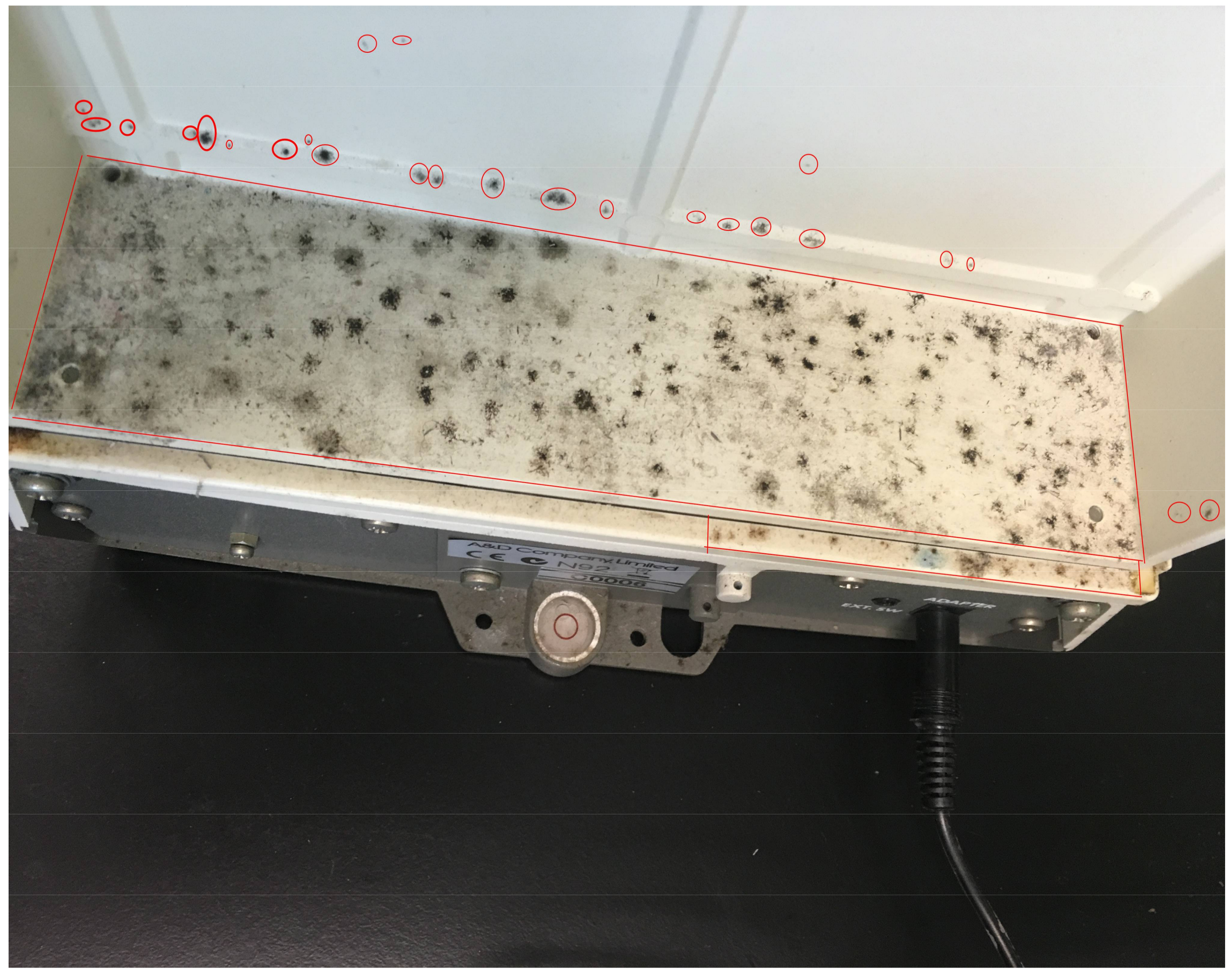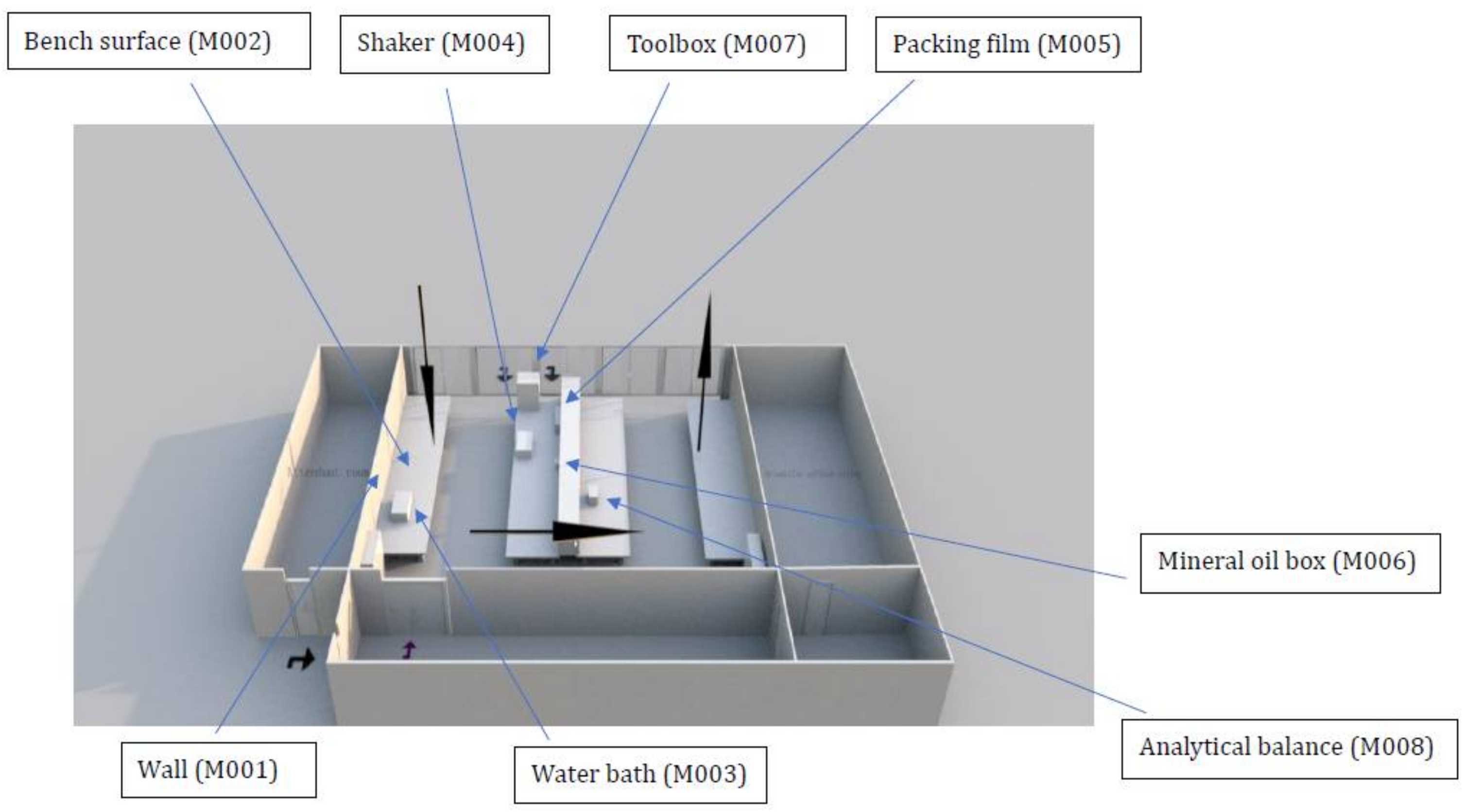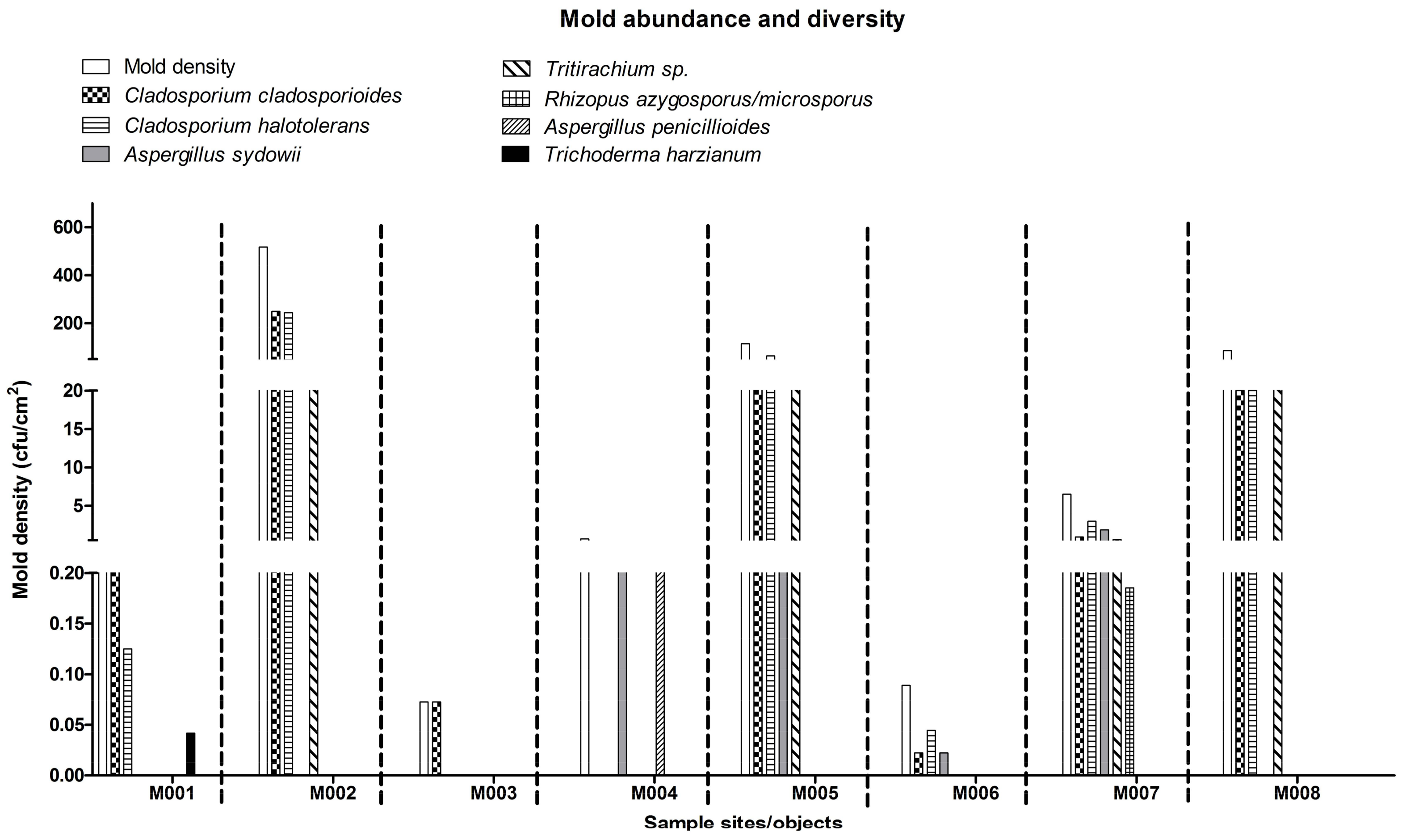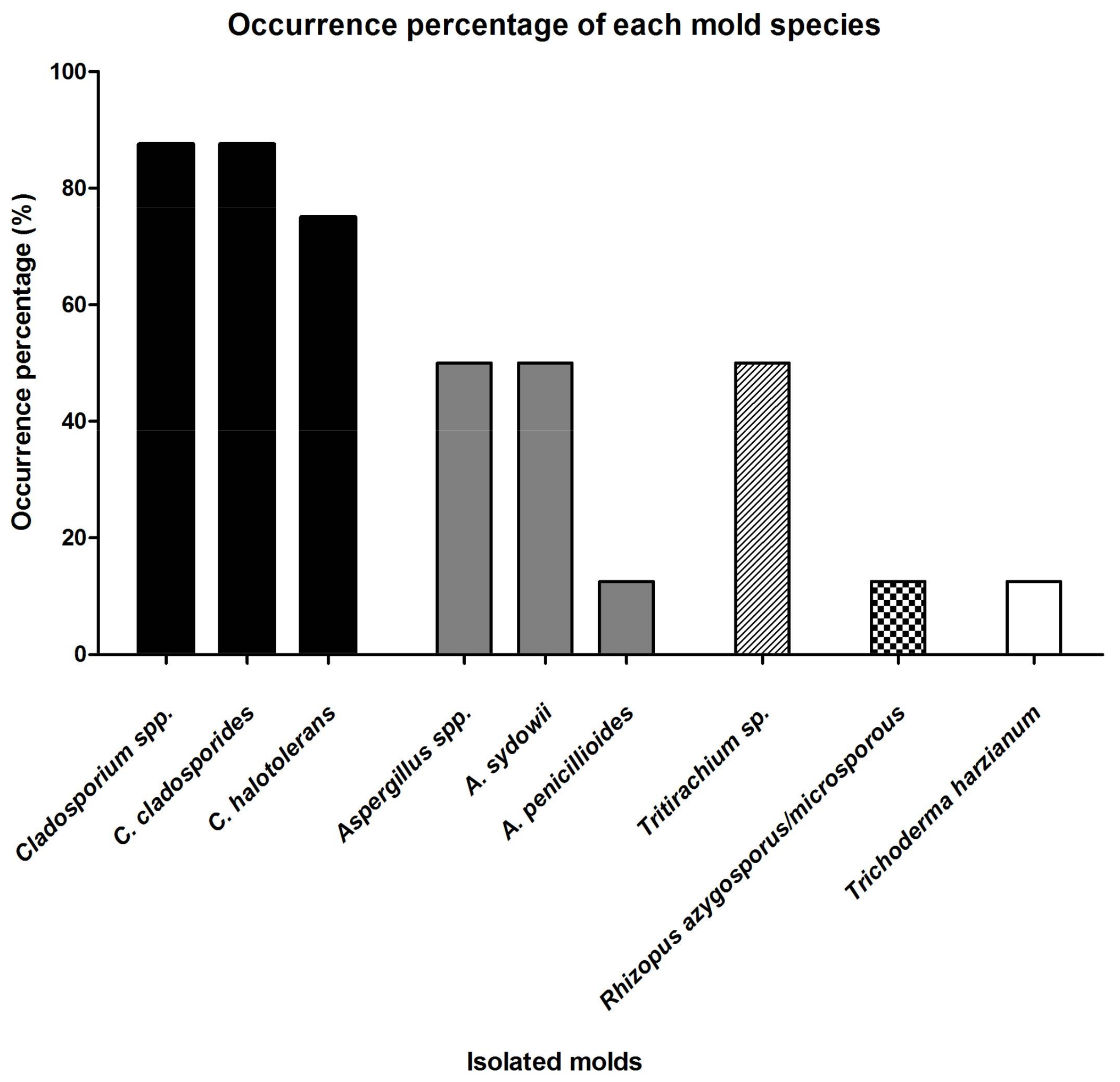Environmental Sustainability and Mold Hygiene in Buildings
Abstract
:1. Introduction
2. Materials and Methods
2.1. Sampling and Cultivation
2.2. Species Identification
2.3. Mold Contamination Scenarios
3. Results
3.1. Mold Contaminated Areas and Environmental Conditions
3.2. Mold Occurrence Percentage
3.3. Ecological Niches and Growth Requirements of the Isolated Molds
3.4. Mold Contamination Scenarios
4. Discussion
4.1. Health Effects of the Isolated Molds
4.2. Mold Control Measures
4.2.1. Maintain RH to 70%
4.2.2. Increase Room Temperature of the Adjacent Room
4.2.3. Reduce Warm and Humid Air Infiltration
4.2.4. Control Nutrient for Mold Growth
5. Conclusions
Author Contributions
Conflicts of Interest
References
- World Green Building Council (WGBC). What is Green Building? Available online: http://www.worldgbc.org/what-green-building (accessed on 1 July 2017).
- Hong Kong Electric (HK Electric). Estimated Running Cost of Electrical Appliances. Available online: https://www.hkelectric.com/en/customer-services/billing-payment-electricity-tariffs/know-more-about-electricity-consumption/estimated-electricity-cost-of-common-appliances (accessed on 1 July 2017).
- The Government of Hong Kong Special Administrative Region (GovHK). 25.5 Deg C and Human Comfort. Available online: https://www.emsd.gov.hk/filemanager/conferencepaper/en/upload/22/HKIE_Environment_Annual_Seminar_Paper_25.5_deg_C_and_Human_Comfort.pdf (accessed on 1 July 2017).
- Sedlbauer, K. Prediction of Mould Fungus Formation on the Surface of and Inside Building Components. Ph.D. Thesis, Fraunhofer Institute for Building Physics, Stuttgart, Germany, 2001. [Google Scholar]
- Ojanen, T.; Viitanen, H.; Peuhkuri, R.; Lähdesmäki, K.; Vinha, J.; Salminen, K. Mold growth modeling of building structures using sensitivity classes of materials. In Proceedings of the ASHRAE Buildings XI Conference, Clearwater Beach, FL, USA, 5–9 December 2010. [Google Scholar]
- WHO Regional Office Europe. WHO Guidelines for Indoor Air Quality: Dampness and Mould; WHO Regional Office Europe: Copenhagen, Denmark, 2009; pp. 12–89. ISBN 9789289041683. [Google Scholar]
- Hong Kong Environmental Protection Department (EPD). Common IAQ Pollutants. Available online: http://www.iaq.gov.hk/en/iaq/common-iaq-pollutants.aspx (accessed on 2 March 2018).
- United States Environmental Protection Agency (USEPA). Mold and Health. Available online: https://www.epa.gov/mold/mold-and-health (accessed on 2 March 2018).
- United States Environmental Protection Agency (USEPA). EPA Technology for Mold Identification and Enumeration. Available online: https://irp-cdn.multiscreensite.com/c4e267ab/files/uploaded/gCQnkBNWQuSD96fPIikY_EPA_Technology%20for%20Mold%20Identification%20and%20Enumeration.pdf (accessed on 30 June 2017).
- Liu, D. Molecular Detection of Human Fungal Pathogens; CRC Press: Boca Raton, FL, USA, 2011; p. 778. ISBN 9781439812402. [Google Scholar]
- Lawrence, M.G. The relationship between relative humidity and the dew point temperature in moist air: A simple conversion and applications. Bull. Am. Meteorol. Soc. 2005, 86, 225–233. [Google Scholar] [CrossRef]
- Dillon, H.K.; Heinsohn, P.A.; Miller, J.D. Field Guide for the Determination of Biological Contaminants in Environmental Samples; American Industrial Hygiene Association: Falls Church, VA, USA, 2005; p. 32. ISBN 0932627765. [Google Scholar]
- Vesper, S.; McKinstry, C.; Haugland, R.; Wymer, L.; Bradham, K.; Ashley, P.; Cox, D.; Dewalt, G.; Friedman, W. Development of an environmental relative moldiness index for US homes. J. Occup. Environ. Med. 2007, 49, 829–833. [Google Scholar] [CrossRef] [PubMed]
- Levinskaitė, L.; Paškevičius, A. Fungi in water-damaged buildings of Vilnius old city and their susceptibility towards disinfectants and essential oils. Indoor Built Environ. 2012, 22, 766–775. [Google Scholar] [CrossRef]
- Aihara, M.; Tanaka, T.; Ohta, T.; Takatori, K. Effect of temperature and water activity on the growth of Cladosporium sphaerospermum and Cladosporium cladosporioides. Biocontrol Sci. 2002, 7, 193–196. [Google Scholar] [CrossRef]
- Bensch, K.; Braun, U.; Groenewald, J.Z.; Crous, P.W. The genus Cladosporium. Stud. Mycol. 2012, 72, 1–401. [Google Scholar] [CrossRef] [PubMed]
- Segers, F.J.; van Laarhoven, K.A.; Huinink, H.P.; Adan, O.C.; Wösten, H.A.; Dijksterhuis, J. The indoor fungus Cladosporium halotolerans survives humidity dynamics markedly better than Aspergillus niger and Penicillium rubens despite less growth at lowered steady-state water activity. Appl. Environ. Microbiol. 2016, 82, 5089–5098. [Google Scholar] [CrossRef] [PubMed]
- Prezant, B.; Weekes, D.M.; Miller, J.D. Recognition, Evaluation, and Control of Indoor Mold; American Industrial Hygiene Association: Falls Church, VA, USA, 2008; pp. 47–50. ISBN 9781931504928. [Google Scholar]
- Alker, A.P.; Smith, G.W.; Kim, K. Characterization of Aspergillus sydowii (Thom et Church), a fungal pathogen of Caribbean sea fan corals. Hydrobiologia 2001, 460, 105–111. [Google Scholar] [CrossRef]
- Stevenson, A.; Hamill, P.G.; O'Kane, C.J.; Kminek, G.; Rummel, J.D.; Voytek, M.A.; Dijksterhuis, J.; Hallsworth, J.E. Aspergillus penicillioides differentiation and cell division at 0.585 water activity. Environ. Microbiol. 2017, 19, 687–697. [Google Scholar] [CrossRef] [PubMed]
- Williams, J.P.; Hallsworth, J.E. Limits of life in hostile environments: No barriers to biosphere function? Environ. Microbiol. 2009, 11, 3292–308. [Google Scholar] [CrossRef] [PubMed]
- Wang, Y.; Barth, D.; Tamminen, A.; Wiebe, M.G. Growth of marine fungi on polymeric substrates. BMC Biotechnol. 2016, 16, 3. [Google Scholar] [CrossRef] [PubMed]
- Hyvärinen, A.; Meklin, T.; Vepsäläinen, A.; Nevalainen, A. Fungi and actinobacteria in moisture-damaged building materials—Concentrations and diversity. Int. Biodeterior. Biodegrad. 2002, 49, 27–37. [Google Scholar] [CrossRef]
- Lübeck, M.; Poulsen, S.K.; Lübeck, P.S.; Jensen, D.F.; Thrane, U. Identification of Trichoderma strains from building materials by ITS1 ribotyping, UP-PCR fingerprinting and UP-PCR cross hybridization. FEMS Microbiol. Lett. 2000, 185, 129–134. [Google Scholar] [CrossRef]
- Pitt, J.I.; Hocking, A.D. Fungi and Food Spoilage, 3rd ed.; Springer: New York, NY, USA, 2009; p. 166. ISBN 9780387922072. [Google Scholar]
- Gravesen, S.; Nielsen, P.A.; Iversen, R.; Nielsen, K.F. Microfungal contamination of damp buildings—Examples of risk constructions and risk materials. Environ. Health Perspect. 1999, 107, 505–508. [Google Scholar] [CrossRef] [PubMed]
- Poutahidis, T.; Angelopoulou, K.; Karamanavi, E.; Polizopoulou, Z.S.; Doulberis, M.; Latsari, M.; Kaldrymidou, E. Mycotic encephalitis and nephritis in a dog due to infection with Cladosporium cladosporioides. J. Comp. Pathol. 2009, 140, 59–63. [Google Scholar] [CrossRef] [PubMed]
- Mousavi, B.; Hedayati, M.T.; Hedayati, N.; Ilkit, M.; Syedmousavi, S. Aspergillus species in indoor environments and their possible occupational and public health hazards. Curr. Med. Mycol. 2016, 2, 36–42. [Google Scholar] [CrossRef] [PubMed]
- Hoog, G.S. Atlas of Clinical Fungi, 2nd ed.; CBS: Utrecht, The Netherlands, 2000; p. 505. ISBN 9789070351434. [Google Scholar]
- Naseri, A.; Fata, A.; Najafzadeh, M.J. First case of Tritirachium oryzae as agent of onychomycosis and its susceptibility to antifungal drugs. Mycopathologia 2013, 176, 119–122. [Google Scholar] [CrossRef] [PubMed]
- Cheng, V.C.; Chan, J.F.; Ngan, A.H.; To, K.K.; Leung, S.Y.; Tsoi, H.W.; Yam, W.C.; Tai, J.W.; Wong, S.S.; Tse, H.; et al. Outbreak of intestinal infection due to Rhizopus microsporus. J. Clin. Microbiol. 2009, 47, 2834–2843. [Google Scholar] [CrossRef] [PubMed]
- Van Laarhoven, K.A.; Huinink, H.P.; Adan, O.C. A microscopy study of hyphal growth of Penicillium rubens on gypsum under dynamic humidity conditions. Microb. Biotechnol. 2016, 9, 408–418. [Google Scholar] [CrossRef] [PubMed]
- Hong Kong Environmental Protection Department (EPD). Guidance Notes for the Management of Indoor Air Quality in Offices and Public Places. Available online: http://www.jjnetwork.com.hk/TechnicalReferences/HKEPD_IAQ_Guidance_Note.pdf (accessed on 2 March 2018).
- Kubicek, C.P.; Druzhinina, I.S. (Eds.) Environmental and Microbial Relationships, 3rd ed.; Springer Science & Business Media: Berlin, Germany, 2007; p. 51. ISBN 9783319295305. [Google Scholar]




| Species | Assay Name | Forward Primer (5′-3′) | Reverse Primer (5′-3′) |
|---|---|---|---|
| Aspergillus penicillioides | Apeni2 | ApeniF2: CGCCGGAGACCTCAACC | ApeniR2: TCCGTTGTTGAAAGTTTTAACGA |
| Aspergillus sydowii | Asydo3 | AsydoF1-1: CAACCTCCCACCCGAGAA | AversR1-1: CCATTGTTGAAAGTTTTGACTGATCTTA |
| Cladosporium cladosporioides, svar. 2 | Cclad2 | Cclad2F1: TACAAGTGACCCCGGCTACG | CcladR1: CCCCGGAGGCAACAGAG |
| Trichoderma harzianum | Tharz | TharzF1: TTGCCTCGGCGGGAT | TharzR1: ATTTTCGAAACGCCTACGAGA |
| Rhizopus azygosporus/microsporus | Rh1: TTTCCAGGCAAGCCGGACCG | Rh2: TATTCCCAGCCAACTCGCCAAAT |
| Label | Site/Object | Surface | Surface Area (cm2) | aw | Temp. (°C) | Location | Light Level | Previously Cleaned | Mold Patch Area (cm2) | Visible Dust |
|---|---|---|---|---|---|---|---|---|---|---|
| M001 | Wall | Anti-mold painted cement brick wall | 60,000 | 0.75 | 21.8 | Open | Dim | Bleach | 120 | No |
| M002 | Bench | Thermosetting high-pressure laminates | 42,000 | 0.74 | 21.7 | Hidden | Dim | No | 400 | Yes |
| M003 | Water bath | Metal | 6750 | 0.71 | 20.1 | Open | Room | Bleach | 69 | Yes |
| M004 | Shaker | Metal | 6500 | 0.71 | 19.8 | Open | Room | No | 150 | No |
| M005 | Packing film | Plastic | 5200 | 0.69 | 21.3 | Hidden | Dark | No | 1100 | Yes |
| M006 | Mineral oil box | Plastic | 810 | 0.69 | 21.4 | Hidden | Dark | No | 225 | Yes |
| M007 | Toolbox | Plastic | 5800 | 0.73 | 21.1 | Hidden | Room + sunlight | No | 270 | Yes |
| M008 | Analytical balance | Metal | 2714 | 0.65 | 21.2 | Open | Dim | No | 70 | No |
| Isolated Molds | Ecological Niches and Growth Requirements | Reference |
|---|---|---|
| Cladosporium spp. | Secondary colonizers, generally require 0.8–0.9 aw for growth | [12] |
| Cladosporium cladosporioides | Common indoor mold, requires > 0.87 aw, needs a high level of organic matter, psychrophilic | [13,14,15] |
| Cladosporium halotolerans | Requires > 0.82 aw, can grow under a low level of organic matter, psychrotolerant | [16,17] |
| Aspergillus spp. | Primary colonizers, <0.8 aw | [12] |
| Aspergillus sydowii | Common indoor mold, requires > 0.793 aw, needs a high level of organic matter, halophilic, mesophilic | [13,18,19] |
| Aspergillus penicillioides | Common indoor mold, xerophilic (can grow even at 0.585 aw), could be associated with water damaged buildings | [13,20,21] |
| Tritirachium sp. | Not a common indoor mold, needs a high level of organic matter, halotolerant | [22] |
| Rhizopus spp. | Tertiary colonizers, require > 0.9 aw, normally need a high level of organic matter for growth | [6,14,23] |
| Trichoderma harzianum | Common indoor mold, tertiary colonizer, requires > 0.9 aw, cellulolytic, requires a high level of organic matter, mesophilic, psychrotolerant | [24,25] |
© 2018 by the authors. Licensee MDPI, Basel, Switzerland. This article is an open access article distributed under the terms and conditions of the Creative Commons Attribution (CC BY) license (http://creativecommons.org/licenses/by/4.0/).
Share and Cite
Wu, H.; Ng, T.W.; Wong, J.W.; Lai, K.M. Environmental Sustainability and Mold Hygiene in Buildings. Int. J. Environ. Res. Public Health 2018, 15, 681. https://doi.org/10.3390/ijerph15040681
Wu H, Ng TW, Wong JW, Lai KM. Environmental Sustainability and Mold Hygiene in Buildings. International Journal of Environmental Research and Public Health. 2018; 15(4):681. https://doi.org/10.3390/ijerph15040681
Chicago/Turabian StyleWu, Haoxiang, Tsz Wai Ng, Jonathan WC Wong, and Ka Man Lai. 2018. "Environmental Sustainability and Mold Hygiene in Buildings" International Journal of Environmental Research and Public Health 15, no. 4: 681. https://doi.org/10.3390/ijerph15040681
APA StyleWu, H., Ng, T. W., Wong, J. W., & Lai, K. M. (2018). Environmental Sustainability and Mold Hygiene in Buildings. International Journal of Environmental Research and Public Health, 15(4), 681. https://doi.org/10.3390/ijerph15040681







